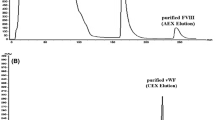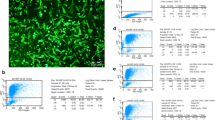Abstract
Hemophilia B is an X-linked recessive bleeding disorder caused by deficiency or malfunctioning of human coagulation factor IX (hFIX). Hemophilia B patients are treated at present by infusion of plasma derived hFIX which is not always efficient, because development of anti-hFIX antibodies (alloantibodies) in some cases inhibits the activity of the infused hFIX. The hFIX alloantibodies are directed against γ-carboxyglutamic acid residues (Gla-domain) or protease domain in hFIX light chain. An epitope-containing fragment of hFIX light-chain was expressed in a T7-based Escherichia coli expression system and after purification, it was used for the immunization of rabbit to develop specific antibodies anti-hFIX. The plasma, derived from the immunized rabbit, was shown to be able to detect the normal hFIX, which indicates for the presence of a specific anti-hFIX antibody and supporting that a bacterially expressed hFIX subfragment might be able to neutralize the alloantibodies. Considering the importance of hFIX and its related investigations, both the produced hFIX antigen and its corresponding antibody will play important roles for experiments dealing with the production of hFIX and studies involved in the neutralization of the hFIX inhibitors in hFIX-related disorders and other clinical applications.





Similar content being viewed by others
References
Lin, S. W., Dunn, J. J., Studier, F. W., & Stafford, D. W. (1987). Biochemistry, 26, 5267–5274. doi:10.1021/bi00391a009.
Takahashi, I., Yako, F., Saito, H., & Kamiya, T. (1998). Peptides, 19, 1129–1136. doi:10.1016/S0196-9781(98)00064-3.
Jackson, C. M., & Nemerson, Y. (1980). Biochemist, 209, 837–846.
van den Brink, E. N., Turenhout, E. A. M., Bank, C. M. C., Fijnvandraat, K., Peters, M., & Voorberg, J. (2000). Blood, 96(2), 540–545.
Lindquist, P. A., Fujikawa, K., & Davie, E. W. (1978). The Journal of Biological Chemistry, 253, 1902–1909.
DiScipio, R. G., Kurachi, K., & Davie, E. W. (1978). Proceedings of the National Academy of Sciences of the United States of America, 61, 1528–1538.
Olivier, D., Christophe, P. J., Lenting, G. C., Mariette, B., Lavergne, J., Boertjes, R., et al. (2001). Blood, 98, 1416–1423. doi:10.1182/blood.V98.5.1416.
Katayama, K., Ericsson, L. H., Enfield, D. L., Walsh, K. A., Neurath, H., & Davie, E. W. (1979). Proceedings of the National Academy of Sciences of the United States of America, 76, 4990–4994. doi:10.1073/pnas.76.10.4990.
Furie, B., Bing, D. H., Feldmann, R. J., Robison, D. J., Burnier, J. P., & Furie, B. C. (1982). The Journal of Biological Chemistry, 257, 3875–3882.
Giannelli, F., Green, P. M., Sommer, S. S., Poon, M. C., Ludwig, M., Schwaab, R., et al. (1998). Nucleic Acids Research, 26, 265–268. doi:10.1093/nar/26.1.265.
White, S. J., Page, S. M., Margaritis, P., & Brownlee, G. G. (1998). Human Gene Therapy, 9, 1187–1195. doi:10.1089/hum.1998.9.8-1187.
Fricke, W. A., & Lamb, M. A. (1993). Seminars in Thrombosis and Hemostasis, 19, 54–61. doi:10.1055/s-2007-994006.
Charlebois, T. S., O’connell, B. D., Adamson, S. R., Brink-Nilsson, H., Jernberg, M., Eriksson, B., et al. (2001). Seminars in Hematology, 38, 32–39. doi:10.1016/S0037-1963(01)90106-4.
Greenhalgh, D. A., Rothnagel, J. A., & Roop, D. R. (1994). The Journal of Investigative Dermatology, 103, 63S–68S. doi:10.1111/1523-1747.ep12399070.
Gerrard, A. J., Hudson, D. L., Brownlee, G. G., & Watt, F. M. (1993). Nature Genetics, 3(2), 180–183. doi:10.1038/ng0293-180.
Page, S. M., & Brownlee, G. G. (1998). Gene Therapy, 5, 394–402. doi:10.1038/sj.gt.3300591.
Sugihara, T. M., Kudryavtseva, E. I., Kumar, V., Horridge, J. J., & Andersen, B. (2001). The Journal of Biological Chemistry, 276, 33036–33044. doi:10.1074/jbc.M103000200.
Kaufman, C. K., Sinha, S., Bolotin, D., Fan, J., & Fuchs, E. (2002). Molecular and Cellular Biology, 22(12), 293–308. doi:10.1128/MCB.22.12.4293-4308.2002.
Aneskievich, B. J., Letai, A. G., & Fuchs, E. (1995). Somatic gene therapy. In Chang P. L. (Ed.). Baca Raton, FL: CRC; pp. 73–90.
Hosseini, S. J., Zomorodipour, A., Jalal, R., & Sabooni, F. (2006). Blood (khoon), 4(1), 17–27.
Lozier, J. N., Tayebi, N., & Zhang, P. (2005). Blood, 105, 1029–1035. doi:10.1182/blood-2004-03-1126.
Mingozzi, F., Liu, Y., Dobrzynski, E., Kaufhold, A., & Liu, J. H. (2003). The Journal of Clinical Investigation, 111, 1347–135.
Scandella, D., Mahoney, S. D., Mattingly, M., Roeder, D., Timmons, L., & Fulcher, C. A. (1988). Proceedings of the National Academy of Sciences of the United States of America, 85, 6152–6156. doi:10.1073/pnas.85.16.6152.
Smbrook, J., & Russell, D. W. (2001). Molecular cloning—a laboratory manual, cold spring. New York: Harbor Laboratory.
Altschul, S. F., Madden, T. L., Schäffer, A. A., Zhang, J., Zhang, Z., Miller, W., et al. (1997). Nucleic Acids Research, 55, 3389–3405. doi:10.1093/nar/25.17.3389.
Libby, R., Braedt, G., Kronheyim, S., March, C. J., Urdal, D. L., Chiaverotti, T. A., et al. (1987). DNA (Mary Ann Liebert, Inc.), 6, 221–229.
Laemmli, U. K. (1970). Nature, 227, 680–685. doi:10.1038/227680a0.
Bradford, M. M. (1976). The Journal of Biological Chemistry, 72, 248–254.
Lim, H. K., Jung, K. H., Park, D. H., & Ching, S. I. (2000). Applied Microbiology and Biotechnology, 53, 201–208. doi:10.1007/s002530050009.
Kiany, J., Zomorodipour, A., Ahmadzadeh Raji, M., & Sanati, M. H. (2003). Journal of Sciences, Islamic Republic of Iran, 14, 311–316.
Ghasemi, F., Zomorodipour, A., Shojai, Sh., Ataei, F., Khodabandeh, M., & Sanati, M. H. (2004). Iranian Journal of Biotechnology, 2, 250–260.
Amiri Yekta, A., Zomorodipour, A., Khodabandeh, M., Daliri Chopari, M., & Kafilzadeh, F. (2006). Iranian Journal of Biotechnology, 4(2), 104–111.
Calvez, H. L., Green, J. M., & Baty, D. (1996). Gene, 170, 51–55. doi:10.1016/0378-1119(95)00850-0.
Berges, H., Joseph-Liauzun, E., & Fayet, O. (1996). Applied and Environmental Microbiology, 62, 55–60.
Makrides, S. C. (1996). Microbiological Reviews, 60, 512–538.
Fulcher, C. A., Graaf Mahoney, S., Roberts, J. R., Kasper, C. K., & Zimmerman, T. S. (1985). Proceedings of the National Academy of Sciences of the United States of America, 82, 7728–7732. doi:10.1073/pnas.82.22.7728.
Toole, J. J., Knopf, J. L., Wozney, J. M., Sultzman, L. A., Buecker, J. L., & Pittman, D. D. (1984). Nature, 312, 312–342. doi:10.1038/312342a0.
Scandella, D., Gilbert, G. E., Shima, M., Nakai, H., Eaglson, C., Flech, M., et al. (1995). Blood, 86, 1811–1819.
Chaves, D. G., Rodrigues, C. V., Ferreira, W. A., Siqueira, P. F. M., Duarte, C. G., de Freitas, A. B., et al. (2006). Brazilian Archives of Biology and Technology, 49(4), 605–609. doi:10.1590/S1516-89132006000500010.
Takahashia, I., Kojimab, T., Sanoc, M., Watanabed, T., Kamiyaa, T., & Saitob, H. (2000). Peptides, 21, 603–608. doi:10.1016/S0196-9781(00)00204-7.
Bowen, D. J. (2002). Molecular Pathology, 55, 1–18. doi:10.1136/mp.55.1.1.
Acknowledgment
The authors are thankful to Mr. Karkhane for valuable technical advices and to Mrs. Fariba Attaie for valuable suggestions on the paper. This work was also supported by a grant from the National Institute for Genetic Engineering and Biotechnology of Iran.
Author information
Authors and Affiliations
Corresponding author
Additional information
An erratum to this article can be found at http://dx.doi.org/10.1007/s12010-009-8742-5
Rights and permissions
About this article
Cite this article
Safari, S., Zomorodipour, A., Amirmozaffari, N. et al. Use of a Bacterially Expressed Human Factor IX Light Chain to Develop Polyclonal Antibody Anti-hFIX. Appl Biochem Biotechnol 159, 404–414 (2009). https://doi.org/10.1007/s12010-008-8506-7
Received:
Accepted:
Published:
Issue Date:
DOI: https://doi.org/10.1007/s12010-008-8506-7




